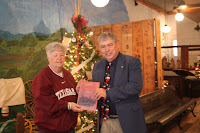"Lone Star Historian" is a blog about the travels and activities of the State Historian of Texas. Bill O'Neal was appointed to a two-year term by Gov. Rick Perry on August 22, 2012, at an impressive ceremony in the State Capitol. Bill is headquartered at Panola College (www.panola.edu) in Carthage, where he has taught since 1970. For more than 20 years Bill conducted the state's first Traveling Texas History class, a three-hour credit course which featured a 2,100-mile itinerary. In 2000 he was awarded a Piper Professorship, and in 2012 he received the Lifetime Achievement Award from the Wild West Historical Association. Bill has published almost 40 books, half about Texas history subjects, and in 2007 he was named Best Living Non-Fiction Writer by True West Magazine.
Two days after Christmas, on Thursday morning, December 27, I spoke at the dedication ceremony of the Mount Pleasant Cemetery Reclamation. The reclamation of the pioneer cemetery in rural Panola County is the tenth such project completed by Elvy J. Adams. Since his retirement as a minister in 2005, Adams has dedicated himself to reclaiming forgotten, overgrown cemeteries. Nine of the cemeteries have been in Panola County, the other in Shelby County.
Elvy J. Adams is a native of Panola County. Born and raised on a farm near Beckville, when he was 16 his mother permitted him to join the United States Air Force. Although he was underage, there was no birth certificate, and in 1948 the teenager launched a 22-year career in the USAF. Following combat in Korea, he began to drink heavily. But his life changed in 1953.
While at home on leave Adams met a pretty young woman in Carthage. Elvy and Erma Fae Adams will soon celebrate their 60th wedding anniversary. They are the parents of five daughters, and they have 14 grandchildren and 17 great-grandchildren. And early in their marriage, Erma led her husband to religion.
While stationed at Clark Air Force Base in the Philippines, Sergeant Adams was the NCO supervisor of 750 civilian guards. In 1954 he built a church for Filipinos a short distance outside the base. Although uncredentialed as a minister, he continued to build churches in the area. While in the Air Force he completed a high school diploma and pursued a college degree. Adams was credentialed by the Assemblies of God and continued to found and erect churches.
After retiring as a master sergeant in 1970, Adams entered fulltime pastoral work. He organized one congregation after another, and supervised the construction of numerous churches. After retiring from pastoral work in 2005, he found another challenge in reclaiming cemeteries. His first project was at Sugar Hill, north of Beckville, where his great-grandfather (a descendant of President John Adams), grandparents, and other relatives are buried.
After a cemetery is recommended to him, Adams approaches the county commissioner in whose precinct the old graveyard is located, and obtains the use of needed equipment. The county probation office provides workers who owe community service hours. The county surveyor and an archaeology professor from Stephen F. Austin State University develop information about each cemetery. Landowners grant various permissions to Adams with a handshake, and other citizens readily cooperate with the affable and persuasive former pastor.

 Brother Adams asked me to speak at the dedication of his ninth project, the long-neglected cemetery at Grand Bluff, an early-day ferry crossing on the Sabine River in northern Panola County. A few years earlier I had visited the overgrown graveyard while preparing Carthage, an Arcadia book. In November 2012 I returned to the cemetery in preparation for the dedication, and I was astounded at the transformation. The property was cleared, fencing was repaired, broken tombstones were again intact, and well over 100 small crosses marked rows of graves that had been rediscovered.
Brother Adams asked me to speak at the dedication of his ninth project, the long-neglected cemetery at Grand Bluff, an early-day ferry crossing on the Sabine River in northern Panola County. A few years earlier I had visited the overgrown graveyard while preparing Carthage, an Arcadia book. In November 2012 I returned to the cemetery in preparation for the dedication, and I was astounded at the transformation. The property was cleared, fencing was repaired, broken tombstones were again intact, and well over 100 small crosses marked rows of graves that had been rediscovered.  On the morning of November 13 a large crowd assembled at Grand Bluff Cemetery. Brother Adams presided, introducing various individuals who had lent assistance, and briefly recounting the course of his most recent project. There was a prayer of sanctification, and I offered historical perspectives. That evening Brother Adams called me, and I told him how impressed I was with his work and that it was a privilege to participate. His enthusiasm is infectious, and he informed me that the State Historian now was a member of his team!
On the morning of November 13 a large crowd assembled at Grand Bluff Cemetery. Brother Adams presided, introducing various individuals who had lent assistance, and briefly recounting the course of his most recent project. There was a prayer of sanctification, and I offered historical perspectives. That evening Brother Adams called me, and I told him how impressed I was with his work and that it was a privilege to participate. His enthusiasm is infectious, and he informed me that the State Historian now was a member of his team!  |
| E.J. Adams (second from left in white hat) addresses the crowd at Mount Pleasant Cemetery. |
 |
| Descendants of James A. Baker, who died at 38 in 1883, stand behind his tombstone. Destiny Ortigo stands at left with her trumpet. |


























